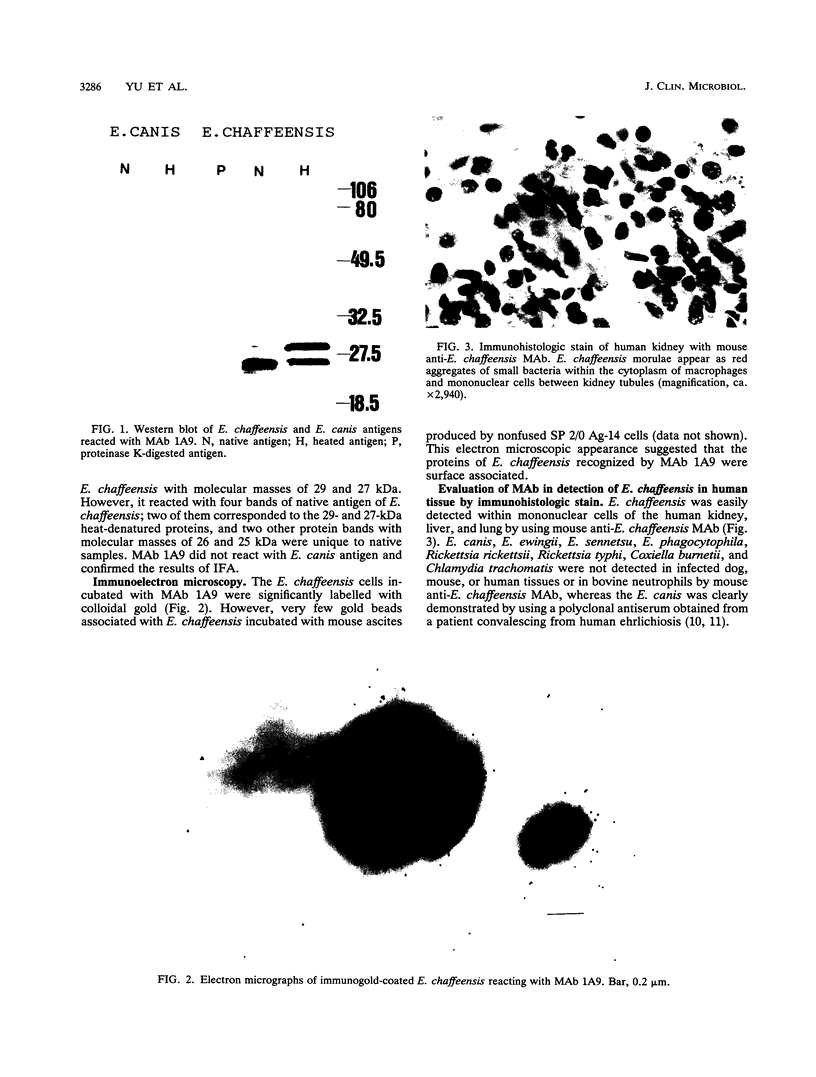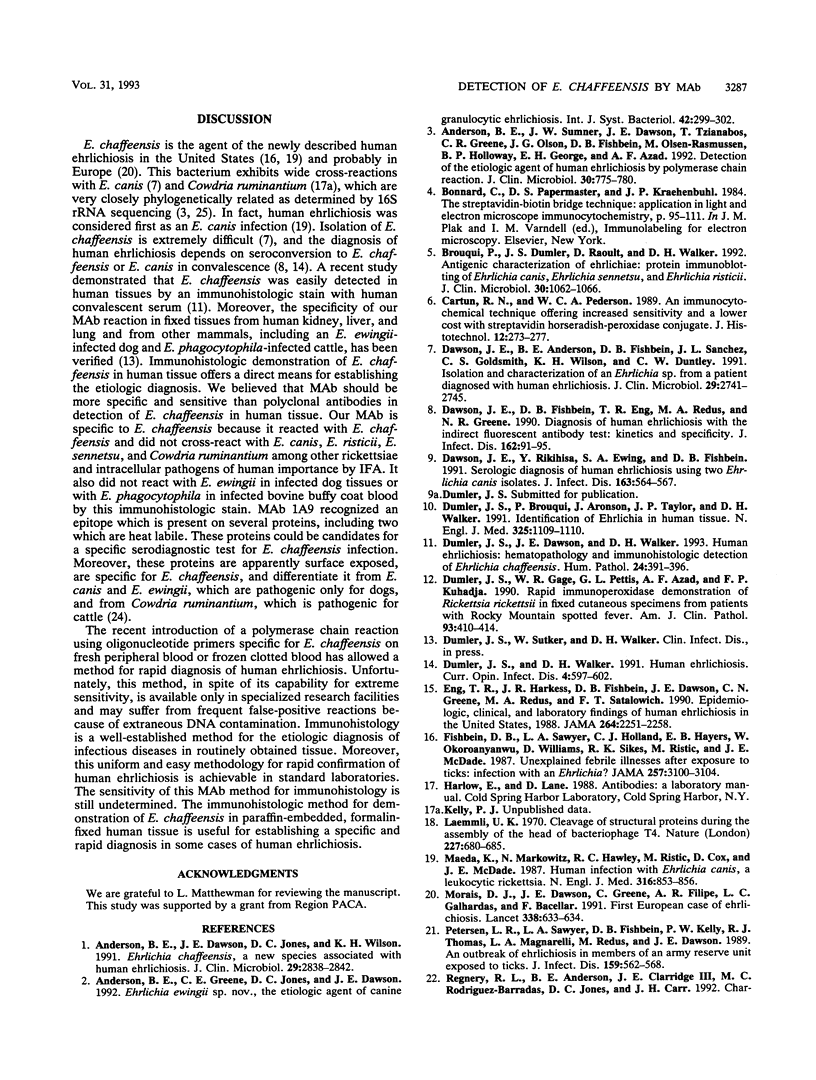Abstract
A mouse monoclonal antibody (MAb 1A9) was produced and used in detection of Ehrlichia chaffeensis in human tissues including kidney, liver, and lung by using an indirect immunohistologic stain. MAb 1A9 was specific to E. chaffeensis and did not react with other bacteria, including Ehrlichia canis, which is the organism most closely related to E. chaffeensis. It reacted with an epitope present in two surface proteins of E. chaffeensis with molecular masses of 29 and 27 kDa. E. chaffeensis was easily detected in human tissue by immunohistology with MAb 1A9. This study demonstrates that our MAb can provide a specific and simple method for detection of E. chaffeensis in clinical specimens for establishing an etiologic diagnosis of human ehrlichiosis; it may also provide a tool for the investigation of immunopathologic characteristics in infected patients.
Full text
PDF




Images in this article
Selected References
These references are in PubMed. This may not be the complete list of references from this article.
- Anderson B. E., Dawson J. E., Jones D. C., Wilson K. H. Ehrlichia chaffeensis, a new species associated with human ehrlichiosis. J Clin Microbiol. 1991 Dec;29(12):2838–2842. doi: 10.1128/jcm.29.12.2838-2842.1991. [DOI] [PMC free article] [PubMed] [Google Scholar]
- Anderson B. E., Greene C. E., Jones D. C., Dawson J. E. Ehrlichia ewingii sp. nov., the etiologic agent of canine granulocytic ehrlichiosis. Int J Syst Bacteriol. 1992 Apr;42(2):299–302. doi: 10.1099/00207713-42-2-299. [DOI] [PubMed] [Google Scholar]
- Anderson B. E., Sumner J. W., Dawson J. E., Tzianabos T., Greene C. R., Olson J. G., Fishbein D. B., Olsen-Rasmussen M., Holloway B. P., George E. H. Detection of the etiologic agent of human ehrlichiosis by polymerase chain reaction. J Clin Microbiol. 1992 Apr;30(4):775–780. doi: 10.1128/jcm.30.4.775-780.1992. [DOI] [PMC free article] [PubMed] [Google Scholar]
- Brouqui P., Dumler J. S., Raoult D., Walker D. H. Antigenic characterization of ehrlichiae: protein immunoblotting of Ehrlichia canis, Ehrlichia sennetsu, and Ehrlichia risticii. J Clin Microbiol. 1992 May;30(5):1062–1066. doi: 10.1128/jcm.30.5.1062-1066.1992. [DOI] [PMC free article] [PubMed] [Google Scholar]
- Dawson J. E., Anderson B. E., Fishbein D. B., Sanchez J. L., Goldsmith C. S., Wilson K. H., Duntley C. W. Isolation and characterization of an Ehrlichia sp. from a patient diagnosed with human ehrlichiosis. J Clin Microbiol. 1991 Dec;29(12):2741–2745. doi: 10.1128/jcm.29.12.2741-2745.1991. [DOI] [PMC free article] [PubMed] [Google Scholar]
- Dawson J. E., Fishbein D. B., Eng T. R., Redus M. A., Green N. R. Diagnosis of human ehrlichiosis with the indirect fluorescent antibody test: kinetics and specificity. J Infect Dis. 1990 Jul;162(1):91–95. doi: 10.1093/infdis/162.1.91. [DOI] [PubMed] [Google Scholar]
- Dawson J. E., Rikihisa Y., Ewing S. A., Fishbein D. B. Serologic diagnosis of human ehrlichiosis using two Ehrlichia canis isolates. J Infect Dis. 1991 Mar;163(3):564–567. doi: 10.1093/infdis/163.3.564. [DOI] [PubMed] [Google Scholar]
- Dumler J. S., Brouqui P., Aronson J., Taylor J. P., Walker D. H. Identification of Ehrlichia in human tissue. N Engl J Med. 1991 Oct 10;325(15):1109–1110. doi: 10.1056/NEJM199110103251517. [DOI] [PubMed] [Google Scholar]
- Dumler J. S., Dawson J. E., Walker D. H. Human ehrlichiosis: hematopathology and immunohistologic detection of Ehrlichia chaffeensis. Hum Pathol. 1993 Apr;24(4):391–396. doi: 10.1016/0046-8177(93)90087-w. [DOI] [PubMed] [Google Scholar]
- Dumler J. S., Gage W. R., Pettis G. L., Azad A. F., Kuhadja F. P. Rapid immunoperoxidase demonstration of Rickettsia rickettsii in fixed cutaneous specimens from patients with Rocky Mountain spotted fever. Am J Clin Pathol. 1990 Mar;93(3):410–414. doi: 10.1093/ajcp/93.3.410. [DOI] [PubMed] [Google Scholar]
- Eng T. R., Harkess J. R., Fishbein D. B., Dawson J. E., Greene C. N., Redus M. A., Satalowich F. T. Epidemiologic, clinical, and laboratory findings of human ehrlichiosis in the United States, 1988. JAMA. 1990 Nov 7;264(17):2251–2258. [PubMed] [Google Scholar]
- Fishbein D. B., Sawyer L. A., Holland C. J., Hayes E. B., Okoroanyanwu W., Williams D., Sikes K., Ristic M., McDade J. E. Unexplained febrile illnesses after exposure to ticks. Infection with an Ehrlichia? JAMA. 1987 Jun 12;257(22):3100–3104. [PubMed] [Google Scholar]
- Laemmli U. K. Cleavage of structural proteins during the assembly of the head of bacteriophage T4. Nature. 1970 Aug 15;227(5259):680–685. doi: 10.1038/227680a0. [DOI] [PubMed] [Google Scholar]
- Maeda K., Markowitz N., Hawley R. C., Ristic M., Cox D., McDade J. E. Human infection with Ehrlichia canis, a leukocytic rickettsia. N Engl J Med. 1987 Apr 2;316(14):853–856. doi: 10.1056/NEJM198704023161406. [DOI] [PubMed] [Google Scholar]
- Morais J. D., Dawson J. E., Greene C., Filipe A. R., Galhardas L. C., Bacellar F. First European case of ehrlichiosis. Lancet. 1991 Sep 7;338(8767):633–634. doi: 10.1016/0140-6736(91)90644-5. [DOI] [PubMed] [Google Scholar]
- Petersen L. R., Sawyer L. A., Fishbein D. B., Kelley P. W., Thomas R. J., Magnarelli L. A., Redus M., Dawson J. E. An outbreak of ehrlichiosis in members of an Army Reserve unit exposed to ticks. J Infect Dis. 1989 Mar;159(3):562–568. doi: 10.1093/infdis/159.3.562. [DOI] [PubMed] [Google Scholar]
- Rikihisa Y., Pretzman C. I., Johnson G. C., Reed S. M., Yamamoto S., Andrews F. Clinical, histopathological, and immunological responses of ponies to Ehrlichia sennetsu and subsequent Ehrlichia risticii challenge. Infect Immun. 1988 Nov;56(11):2960–2966. doi: 10.1128/iai.56.11.2960-2966.1988. [DOI] [PMC free article] [PubMed] [Google Scholar]
- van Vliet A. H., Jongejan F., van der Zeijst B. A. Phylogenetic position of Cowdria ruminantium (Rickettsiales) determined by analysis of amplified 16S ribosomal DNA sequences. Int J Syst Bacteriol. 1992 Jul;42(3):494–498. doi: 10.1099/00207713-42-3-494. [DOI] [PubMed] [Google Scholar]





